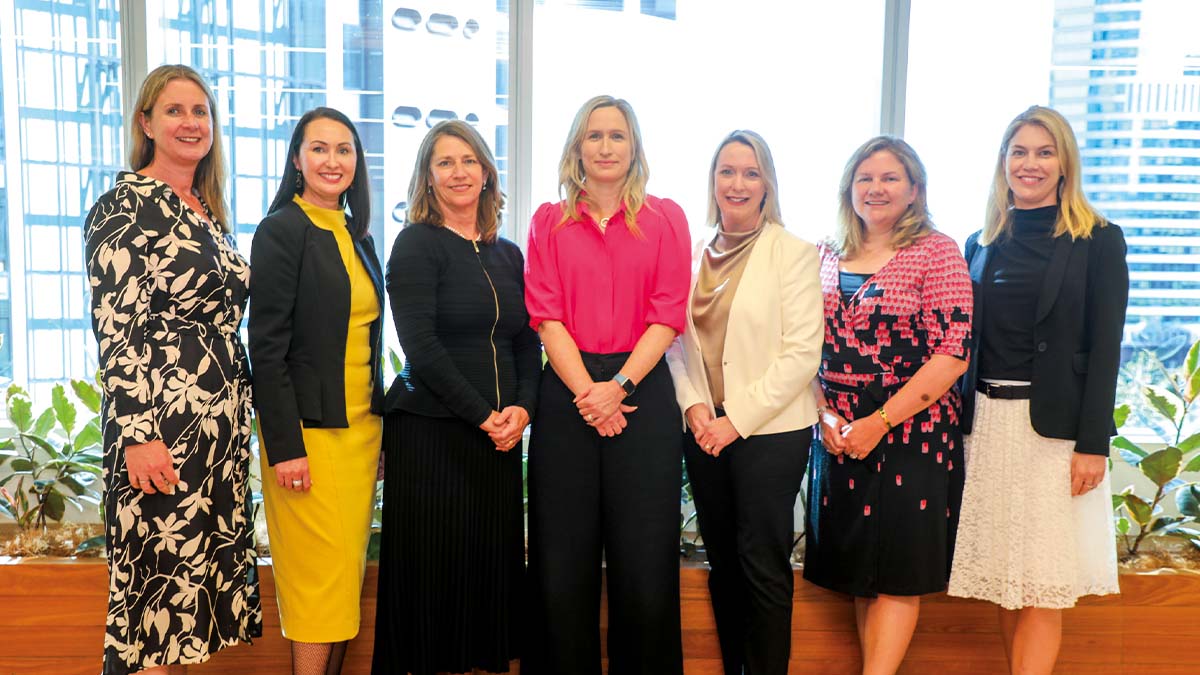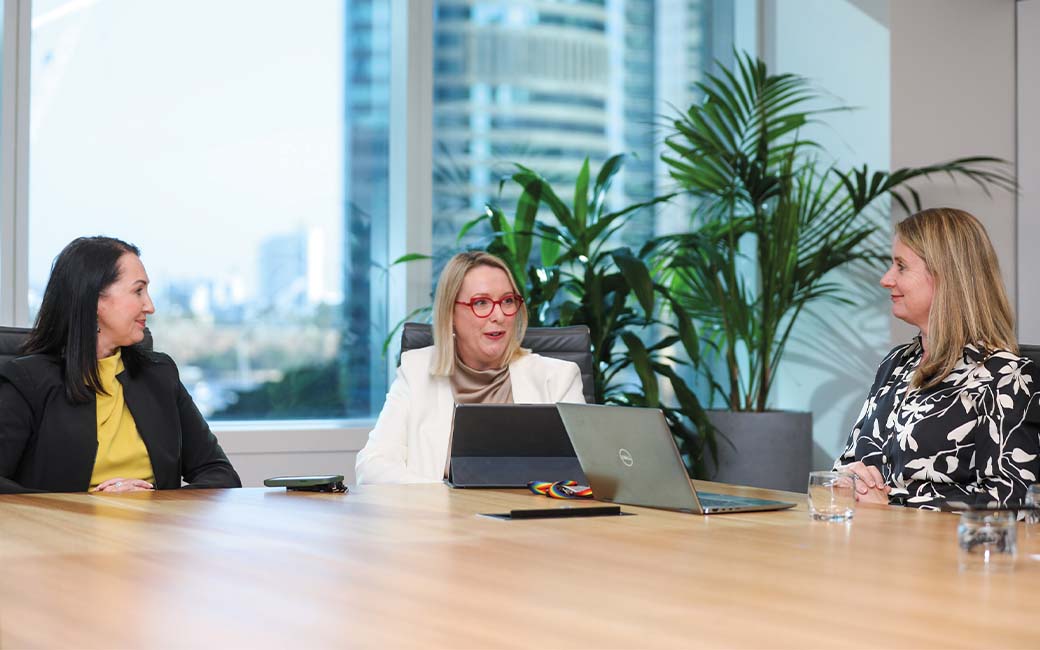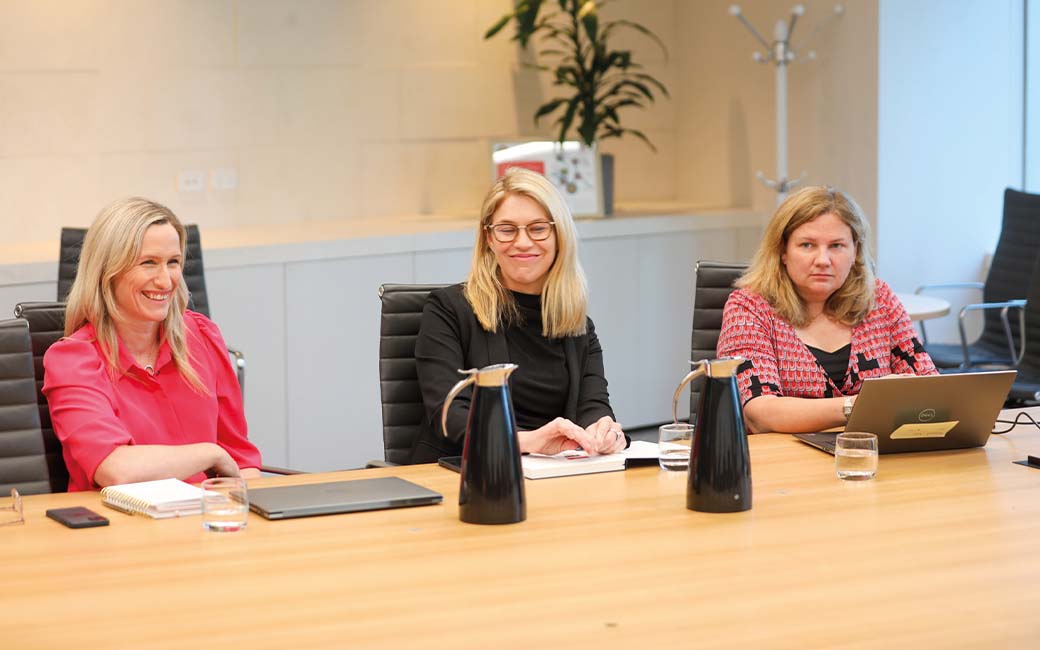
Strategy and sustainability on the leading edge of investment approach
QIC has established a reputation as a leader in Australian sustainable investment, as well as for its wide-ranging and innovative strategic approach across asset classes. Female leaders from across the QIC business met with KangaNews at a roundtable in Brisbane in November, to discuss the macroeconomic and geopolitical inflection point – and the asset allocation response – as well as the mounting scale and urgency of the sustainable transition task.

OUTLOOK AND POSITIONING
Craig QIC has made some big shifts in strategic asset allocation. How does this relate to the company’s macro view?
A HILL Volatility is a key word to be focusing on as we look forward. We have come from an environment in which central banks were cutting rates and, especially since the financial crisis, the Fed [US Federal Reserve] was largely there as a backstop. As soon as there was too much volatility in markets, the Fed would step in and things would calm.
This era has finished, and the Fed and other central banks have clearly focused on their inflation-targeting mandates as their central purpose. Cash rates have risen rapidly and, more recently, nominal yields have risen too. All this creates a challenging market for investments across the public and private segments. Our portfolios in the state investments team cover all asset classes globally and we have been thinking about how to position ourselves for the future while also ensuring we are building resilience into the portfolio.
It is very hard to predict the future, but we can try to prepare for it. This is what we are doing: preparing
by building strategies within our portfolios such that, as environments eventuate, we have parts of the portfolio that will do well even while others might be a little more challenged on a shorter-term horizon.
Over the longer term, it is about focusing on the net risk-adjusted return and making sure we provide real returns to government.
Craig How important is it to be able to act quickly in this kind of environment?
A HILL Very. As a long-term investor, we look through the noise toward a longer-term horizon. Of course, from time to time opportunities arise that are interesting to lean into. Our private debt business is one example: we are building this out because we think it offers a compelling return.
This is an example of a longer-term thematic or secular change. Banking regulations are changing such that the cost to banks of holding debt is increasing, so they are withdrawing from the market to the extent that borrowers are looking for alternative lenders.
This trend is here to stay and it is certainly one we are keen to lean into if we can get strong credit quality, good selection of opportunities and compelling rates of return. It is a balance, but we try to take advantage of opportunities when they arise.
MORRIS One of our points of difference in how we manage credit and fixed-income portfolios is how we use our derivatives expertise. We make frequent use of credit derivatives, but there are significant differences in functionality and liquidity between jurisdictions so having the in-house expertise to know the differences is quite important. Our clients are also using these tools more than they have historically as they seek more flexibility in their allocations.
TOWERS This links to the implementation piece. My role is to work with the team and our clients, to hear all their views and how they want to be positioned, and understand how best to implement everything in particular through synthetic markets.
In order to do this, we also have to understand liquidity and the markets within which we are working to enable clients to get the right outcome and be able to express what they need. We have to be across various different markets and be ready to be nimble for the team as well as clients.


Craig Which macro theme have you have been keeping the closest eye on in 2023 and how does it feature in your outlook for 2024?
A HILL Reshaping of supply channels affects onshoring and offshoring. The focus is on securing essential services, of which defence is a big part – as is energy sourcing, food, and national security more broadly. A lot of this is really transformative in the sense of of where manufacturing happens and cost structures. If there are duplications of existing pathways, this is potentially inflationary as well.
K HILL Our base case is for a short and shallow recession in the US next year and a continuing per capita recession in Australia. But there is so much uncertainty at the moment – the impact of the pandemic has distorted multiple economic indicators.
Our view is anchored by deterioration in the labour market. We aren’t seeing outright job losses but there has been a slowdown in hiring and it is taking people longer to find a job. Job creation is also increasingly concentrated in part-time jobs.
All this means household income growth will likely be a bit slower going forward. Household saving rates are already quite low and they really can’t go down much further, which means we can’t expect much more of a boost to household spending from reducing savings.
All this leads us to anticipate that the US will go into a mild recession next year and growth will be soft in Australia.
TIERNAN My role is to make the top-down macro credit call. In the long term, we are structurally positive on liquid credit. One thing to consider here is the health of Australian companies – which is very strong, especially from the credit fundamental side.
From a short-term perspective, it is challenging to identify an overall narrative that is driving the market. Take data releases: one day they are very positive, the next they are negative. This makes for a very difficult environment in which to get the call right. Our overall view, as has been said, is that we are going to go into a short and shallow recession.
Getting the timing of all this correct is the near-term challenge, especially when the various economic releases lead to such volatility in the rates market.
We need to understand what is driving the rates market because this will also drive credit in the short term. I say this even though, in the long term, we believe fundamentals are a much more important part of the call.
WARD The economic downturn and likelihood of a recession is interesting. We can look at the data points and then see something quite different in consumer sentiment. This is definitely worth watching. The volume of bank issuance in the Australian market, and the quality of deal books, is something else to keep an eye on.
MORRIS I agree that investors are having to grapple with multiple factors at the moment. There’s the shorter-term, cyclical aspect, which Marayka has touched on – are we going into a recession or not and, if so, will it be a shallow or deep one – but there is also a structural element. Several structural forces are at play that have changed from the last decade or two. We don’t know exactly where some of these will land, but they are undoubtedly the influential factors that will drive where investors end up placing their capital over the longer term.
We have clearly seen a very sharp rise in yields. For fixed-income investors like ourselves, this has changed the landscape and the conversations we are having with clients. But we do not yet know where the equilibrium position is.
Several long-held and deeply rooted beliefs – all the big anchors that investors were really sure of in the last couple of decades – are now being reassessed. For instance, inflation was expected to be low and stable, while real interest rates would remain low due to secular forces. Investors are now having to reassess these key principles and assumptions, and I think we are probably only at the very beginning of this reassessment.
Craig Are QIC’s clients on board with the significance of these structural changes?
MORRIS It is a conversation we will be having a lot more going forward. I don’t believe a lot of investors have reset the very long-term expectations just yet or adjusted them in a big way. Potentially, there are more adjustments to come.
On the other hand, increased allocations are coming into fixed income. Interestingly, volatility and the changing macro environment are bringing back active management and moving us away from the passive trend of the past decade. There is a lot more opportunity in active management in the current environment.
Our liquid markets group does not just cover fixed income: we manage multiasset derivatives overlays and implementation as well. The combination of these capabilities means we are experiencing a lot of interest in the flexibility derivative markets can provide – and this is not just fixed-income derivatives, but other asset classes as well. Investors are recognising the need to be more nimble in the current macro environment, and they are seeking out more effective and efficient ways to enable this.
RAMPA As a thematic investor, we shape our business around key themes. Something I’m focused on is the longer-term impact of major geopolitical issues. A particular focus is China, as a significant trading partner for Australia. China’s propensity now is to have and tolerate lower growth, but also to shift the levers it has historically used on infrastructure and real estate to drive the economy. China is shifting to technology as an economic driver.
The question we are thinking about is what the longer-term impact of this will be on our resources sector and on the energy transition challenge Australia is facing. We have the strength of the resources sector, which means we have a very strong comparative advantage in energy transition and an opportunity to accelerate it. With this in mind, we have been aligning our business from a capability perspective and the investments we have been making.
The questions we are asking are whether acceleration is needed and, if so, what the funding models should be. This includes whether there is opportunity for private capital to participate in the energy transition. This is a significant shift occurring in the world and we are actively investing in our ESG [environmental, social and governance] capability as a result. This is an example of a key theme that provides many opportunities.
A HILL On the topic of geopolitics, the Israel-Hamas conflict has potential ramifications for the oil price. However – somewhat surprisingly – the market has been reasonably steady since the outbreak of the conflict.
A rise in oil prices could be a big inflationary impulse if the conflict were to spread, which would also be destabilising from a sentiment perspective. In fact, it could have quite big impacts on a number of areas and we also keep a mind to the humanitarian perspective – this is clearly a tragedy for civilians living in the region.
We should also recognise that Russia-Ukraine is still a live situation. For example, even though Europe showed remarkable flexibility in redirecting where it got its energy supplies from, if there is a cold winter in Europe it could put pressure on gas prices. This is another factor that could cause some waves through the market.
MORRIS There is a risk of short-term escalation on a number of fronts and there are also longer-term structural impacts that might be influenced by heightened geopolitical risk and which could change the face of economies.
With energy transition, for example, geopolitical influences touch many aspects of the process. There is also a shift away from globalisation and back to onshoring, such as the Inflation Reduction Act in the US that encourages manufacturers to invest domestically. While geopolitical risks can have very big impacts in the short run, they are changing the landscape in the long run as well.
Diversity and breadth complement QIC's competitiveness
A year and a half into new leadership, the story at QIC has been one of evolution not revolution – though the firm believes it remains ahead of the curve structurally, in its investment practice and in the extent to which it has incorporated gender diversity throughout its team and in leadership.
RAMPA I was very fortunate that when I joined QIC nothing was broken – it was already a thriving business. But market conditions were changing, and very quickly, so we needed to adapt and focus on where we felt there were new opportunities. We have a diversified platform – we operate in infrastructure, real estate, natural capital, and private equity and debt. We have our liquid markets group and our state investments arm, and being an asset manager gives us unique insights into the marketplace.
We have further built out a global distribution platform in the past 18 months. This means having executives in the market working with our clients globally, which has been a large investment and a significant initiative by the organisation.
We have built out our private debt platform and capability, which is a great opportunity in the current environment. This has been a key focus of the organisation. We have continued to invest in people on the ground, particularly offshore, in our infrastructure and private equity businesses. In addition, we have of course been focused on the sizeable shifts in strategic asset allocation and managing portfolios in the current market.
Craig There is also a growing view that the Reserve Bank of Australia (RBA) is not yet finished with its tightening cycle, as inflation is stickier here than it is offshore. What impact could further rate rises have on households and businesses?
K HILL The resilience of the housing sector in Australia and the US has been really surprising. In fact, it has probably been one of the greatest economic surprises of 2023. However, we think we are going to experience a softer housing market in Australia and the US into year end.
The RBA is once again lifting the cash rate and the recent rise in US long-end yields will flow through into higher US mortgage rates – which are typically 30-year fixed rates.
TIERNAN So far, companies haven’t shown signs of terrible stress. Banks’ arrears indicators are still healthy and consumer-oriented companies are still all doing very well. This comes back to the point raised earlier about consumers’ excess savings, which they have been drawing down on.
The big question is what happens going forward. We are coming to the end of US earnings season and earnings growth is tracking ahead of analysts’ original estimates for the quarter. This has been driven primarily by a handful of companies in the consumer sector including Amazon, Airbnb, Wynn Resorts, Domino’s and Nike, with tech companies such as Meta also performing well.
However, Amazon’s results were boosted by cloud performance and better efficiency rather than strong consumer demand. US consumers are also drawing down on their excess savings pretty significantly.
The one thing going in favour of the US is that mortgages there are fixed for life. Higher rates will slow down new housing sales, construction and renovation. But consumers don’t face a higher interest bill the way they do in Australia. Nevertheless, we are coming to the end of the excess savings buffer. From here, the question will be how the consumer looks.
AUSTRALIAN CREDIT
Craig How is QIC positioned in credit markets, bearing in mind the high risk-free rate environment?
TIERNAN It is a tricky environment. With yields at decade highs, credit looks relatively attractive. However, the other factors we talked about – such as geopolitics and the economic uncertainty that has led to rates volatility – can have a negative impact on the way credit performs.
We recently reduced our overweight in credit to a neutral position, using the synthetic levers we have discussed. We still like credit over the longer term but going into year-end with this level of geopolitical, interest rate and economic noise, we felt it would be prudent to reduce the overall risk of the position.
WARD We are comfortable with the fundamentals of the issuers we invest in and cover in the Australian market. We are not concerned about default risk – it is very much rates risk for these names. Even though we have moved to neutral, this is a short-term valuation view. We are very comfortable with fundamentals in the medium term.
MORRIS We also hold index-linked bond exposures and from time to time these have been meaningful. We believe these are great assets to own, particularly at current levels of real yield but also from a carry point of view. These bonds provide significant diversification benefits to portfolio construction as well as bringing an extra element of defensive and hedging insurance to fixed-income portfolios.
We can invest globally, but at the moment we favour Australian short-dated linker exposures. These are less liquid than offshore index-linked markets but we have deep experience in these instruments and specialist expertise in our trading team, so we are quite comfortable managing these investments for our clients – even those with very large volume.
TIERNAN If the economic scenario plays out as we expect it could very likely present a buying opportunity for credit, because credit typically widens into recession.
TOWERS Having the flexibility to express our credit view through synthetics also allows us to mitigate liquidity challenges in the secondary market. Being able to express our allocation through synthetics and then, over time, finessing this by getting into more name-driven allocation is definitely beneficial in the sense of maximising liquidity.
WARD It also goes beyond credit derivatives to the way we either hedge or don’t hedge credit using the duration lever. There are lots of opportunities around.
“Having the flexibility to express our credit view through synthetics also allows us to mitigate liquidity challenges in the secondary market. Being able to express our allocation through synthetics and then, over time, finessing this by getting into more name-driven allocation is definitely beneficial.”
Craig Do any particular sectors stand out that QIC is seeking to exploit or, conversely, that it prefers to avoid?
TIERNAN Our approach has been to look for sectors or individual names that we determine to be mispriced. This could be a new deal with a reasonable new-issue concession or a name that looks rich on the secondary curve. We seek to recycle names that have outperformed into other names that we deem to have better relative value.
We are constantly looking through our portfolios for names that appear cheap or expensive, to ascertain the best place for us to invest our clients’ capital. Our aim is to make sure we are not sitting on positions or buying just for the sake of it. We want to make sure there is appropriate relative value on both sides of the trade.
WARD The higher-yield environment is creating more competition between corporates and SSAs [supranational, sovereign and agency issuers]. The higher-rated, triple-A names are quite interesting because they allow some investors to move up in credit rating quality. For the same reason, there is also an opportunity to look at securitisation and bank paper, which have high credit ratings, for attractive yields.
What is different about the SSA sector this year is the pace of deal flow. Going back a few years, SSAs had a traditional issuance period. This year we have seen more consistent issuance, issuers more actively tapping and some club-style deals being printed.
We haven’t looked at this in great detail because we have always played SSAs as a relative-value trade versus semi-government issuers. This is what a lot of the domestic market does. But I suspect we are seeing a change in the investor base in SSAs. More domestic investors are studying the space whereas traditionally it was a small Australian investor group with Japanese buyers coming in for yield and playing the currency as the main driver.
SSAs are very dedicated to keeping their Australian dollar lines open, which means they are less price sensitive in their decisions to access US dollars, euros, sterling or Australian dollars. Corporates, by contrast, tend to be more selective on price. SSAs want to keep this issuance option open because they view the Kangaroo market as being ‘semi-core’ to their issuance programmes.
SSA pricing has looked attractive versus semis recently. But this pocket has been discovered and the sector is starting to look a little tight versus semis. We may start to see some rotation.


Craig Has the functionality of the Australian secondary credit market evolved?
TOWERS The uptick in corporate issuance of late has definitely helped with liquidity. We welcome greater volume as it brings additional liquidity and allows investors to receive bigger parcel sizes, even though deals are mostly oversubscribed leading to scaling in primary.
Issuance activity then leads to follow-on secondary activity and liquidity. This said, we still need to be very close to our dealers to understand inventory and to capitalise on opportunities in the secondary market.
Craig What makes a good deal in the primary credit market at the moment?
WARD There is greater price tightening in some deals than we have seen in the domestic market in a long time. It makes a difference if issuers take a longer-term view about where value is so books can be printed with some flexibility. This way, issuers are getting a good level but so are investors.
TIERNAN All the recent issuance has underscored the importance of having a functioning primary market for price discovery, including for the health of the secondary market. When the whole market has to stop and look at a single name, everyone will take a view on whether it is rich or cheap.
In larger capital markets, like the US or Europe, constant deal flow means this is happening on a daily basis. In Australia, the corporate market was stuck in neutral for so long that the issue has become structural. The banks are a much bigger player in trading here than they are in the US, for example.
It would be great if we could see momentum in the primary market continue – especially the flow of debut names including New Zealand issuers. It is fantastic to witness this activity and it allows market users to make good credit decisions. It is good for the health of the market in the longer term.
New frontiers in sustainable investment strategy
The sustainable finance space is developing at dizzying pace, with enhanced rigour and processes in established areas and new points of focus emerging regularly. Staying on top of these developments is crucial for an investor like QIC.
A HILL Generally there is good intent but the language, measurement, metrics and expectations are changing very, very rapidly and can sometimes be challenging. There have been a couple of headline cases that have heightened awareness.
The issue is that there is no clearly set definition across, or even within, asset classes so measurement is happening on different bases. We think about ESG [environmental, social and governance] issues on an earnings before interest and tax basis so we include debt, but a lot of equity managers don’t. Trying to ensure consistent measurement across managers and to achieve consistent definitions can be challenging.
Even though the intent is there, to me this is all about risk and whether it is being priced appropriately. Undoubtedly there are also opportunities in certain areas. The bar is being lifted on a regular basis and this is a very good thing.
WARD We bought our first labelled bond back in 2014. The risk that we would buy a deal that was greenwashed and so would risk our clients’ money has kept us awake at night, so we put a labelled bond investment standard in place that outlines minimum structural requirements when we are looking at a deal.
These are common sense steps for the kind of structures we should be looking for and the frameworks a bond should be aligned with. This has guided us well and kept us in good stead.
A HILL Labelled products serve a purpose but institutional investors need to go beyond this to ensure ESG is part of every assessment in every asset class. It is a risk that needs to be considered – if it is not, investors are likely not pricing the opportunity appropriately.
An enormous amount of capital is pledged to net zero globally, so getting data and understanding how investors are incorporating ESG – whether or not a bond is labelled – is becoming a heightened expectation.
THE PATH TO DECARBONISATION
Craig How does QIC think about the process of assisting clients with their own decarbonisation priorities, given the landscape of investor engagement and sophistication is such a diverse one?
WARD The demand for analysis is increasing. A few years ago we started noticing clients setting net zero targets at whole-of-portfolio level. We can see where they can pull levers in their real asset portfolios and what they can do to these assets to decarbonise. There is, in particular, a big focus on equity portfolios and the availability of data for listed companies.
We started thinking about what it could mean for fixed-interest portfolios six or seven years ago. We were exploring how to measure emissions in portfolios, what data was available, where the gaps were and how we could model the data gaps to get decent portfolio coverage.
This put us in a very strong position to respond to what we are being asked for now, which includes data on portfolio emissions as well as for ideas on how our clients can start to decarbonise so they are able to include their fixed-interest portfolios in net zero targets.
MORRIS It has been an evolution in our team, particularly for the portfolio managers. But because we started this journey so long ago, it is now integral to our standard investment process that every credit we assess has to include a view on the ESG [environmental, social and governance] elements of the company. There are some very clear examples of the discussions that take place in the team and actionable portfolio decisions that have resulted on ESG grounds.
WARD One example is Hyundai. When our credit analyst in London picked up some information about Hyundai and the potential for modern slavery breaches, we worked very quickly – over a weekend – to verify the information. On the Monday morning, we talked in a portfolio management meeting about the potential we might have to sell those bonds.
A number of years ago we had some concerns about the oil and gas exploration and production (E&P) sector. Our concerns centred on the substitutability of oil, regulations that were starting to outlaw petrol engines, clients’ net zero commitments and their 2030 interim target measurements.
We wanted to know what all this could mean for the spreads on oil E&P bonds by 2030 and whether investors should be holding these bonds by this point. We started to exit this space.
We are having similar discussions now about equivalent risks in the gas transmission space, specifically whether some companies will be able to transition and therefore make us comfortable holding, or whether it is prudent to put a maturity limit on these bonds.
These are discussions between the credit and portfolio management teams. We all sit together – we are part of the same business – so the work we do in the credit space is used for portfolio construction. As a result, there is very good buy-in. A portfolio manager does not want to be holding a bond on which we think spreads are going to widen because of ESG concerns.
Craig On the data front, is it easier to get the information QIC is looking for these days?
WARD Absolutely. The construct of the domestic credit market has a big portion of unlisted issuers. Years ago, we were not able to get data for things like carbon emissions. Part of our engagement programme in the early days was talking to bond issuers about the data points we were looking for and why. When they know we have clients that require us to report these data and what we use the data for, issuers start to understand and engage with us on the structure of reports so they can provide exactly what we are looking for.
Over the years, we have seen a really big increase in the availability of data to the point that we are now getting very high coverage levels. We used to model emissions for companies that were not reporting data and we are finding now that we hardly have to model or make assumptions about emissions data.
The next phase will be to study the integrity of the data that are being reported. Mandatory reporting means the integrity of the data will be subject to further scrutiny, which will reduce our concern.
One aspect of the regulatory focus on greenwashing risk is that we have to ask how data is being calculated. We see some reprints of data and we always query. Once we start to see more verified data use, we will become more comfortable. Certainly, though, data availability has already improved.
Craig How does the integration of ESG into credit analysis work in practice? What are the challenges?
TIERNAN As a credit analyst, it is necessary to separate personal views about what a company should be doing from whether something will jeopardise its ability to generate cash.
We look through the lens of reputational business risk that might be generated by ESG issues. One of the topics Marayka brought up – the transition away from gas – is a good example: will there be new regulations that jeopardise or challenge companies’ underlying ability to generate cash?
MORRIS There is also the concept of opportunities for positive ESG impact. This is really important because the number of discussions we have with clients on ESG is increasing in line with their level of interest. However, there is a spectrum of understanding about ESG in the investor universe – and we find that many clients want to do the ‘right thing’ and put their capital to work in ESG-appropriate ways, sometimes including moving toward labelled products.
We wouldn’t necessarily say this is the best approach for ensuring strong ESG considerations are integrated into portfolios, though. There are opportunities for finding the really good transition stories or the improvers.
WARD We are starting to see very different approaches and therefore opportunities in the data and targets companies are setting. Some haven’t set targets and are not very engaged while other, very similar, companies have started down the path. This means we can start to shape our portfolios toward the companies we think are decarbonising or that are cognisant of ESG risk.
Craig How does labelled versus unlabelled issuance play into this?
WARD Labels are great, but I also believe sustainability-linked bonds (SLBs) can do a lot for decarbonising a portfolio relative to buying an asset that is already green. SLBs are more akin to transition finance. What matters for the portfolio is good ESG credentials, and this doesn’t necessarily mean just having labelled bonds. We would rather have a portfolio that has vanilla bonds from companies with strong ESG credentials.
Having said this, it would be possible to run a labelled bond portfolio in Australia. I wonder, though, about the duration portion of some of the portfolios we see. When we look at the returns of some of the products that are available, we hear investors talking about there being a cost to holding labelled bonds. This cost isn’t because the securities are not performing well – it is because the portfolios are not managed well for duration risk or protected in credit spread widening events.
MORRIS There are examples of labelled bonds that we have consciously chosen not to buy.
WARD This is correct. In some cases, the companies are not ‘walking the talk’ – in other words, it appears that sometimes there is a pricing driver for the issuer rather than a genuine attempt to deal with ESG issues.
Craig How has QIC’s approach to collaborative engagement evolved and is it experiencing the fruits of these efforts?
WARD The strategy has not changed but the formal opportunities to get involved in collaborative engagement are greater now. Groups like IGCC [Investor Group on Climate Change] and the Climate Action 100+ initiative include fixed-income investors. We also have the UN PRI [Principles for Responsible Investment] coordinating collaborative engagement.
To be fair, the ESG space has always been relatively collaborative and investors have been quite open about sharing experiences. There has always been informal collaboration within the domestic fixed-income market, too. Some might not recognise their discussions as engagement, but when a group of investors gets together to ask for data or for a corporate to address an ESG risk, this is exactly what is happening. There is a growing view that a bigger group of investors will have greater influence on companies, banks and governments.
There is also a better understanding that the bond market is a large and important provider of capital. While the listed equity market has done a really good job on stewardship, bond investors also have a seat at the table even without shareholding or voting rights. A big portion of the Ausbond composite bond benchmark is unlisted issuers, so bondholder influence is important.
We are often approached by corporates for discussion about ESG issues. My strong view is that we do not take second place to equity investors.
A HILL In my role I am definitely observing a movement away from exclusionary approaches on the basis that investors want a seat at the table to be part of the solution, and divestment alone does not achieve this.
I’m thinking more about how we can engage in collective action with our peers, because this is how we can implement change. Collective influence is a very important part of the transitional roadmap to achieving net zero.
Craig QIC is part of PRI’s sovereign engagement pilot. Given the importance of sovereigns in fixed-income portfolios, what are you hoping will come out of the study and what risks and opportunities might emerge?
WARD The PRI sovereign engagement pilot is focused on climate risk, including working with the Australian government to understand climate risk and policy, and what is needed. It is very much collaborative, not just among global investors but also with government. The importance of sovereign bonds to the fixed-income benchmark is clear – they comprise more than half the Ausbond composite benchmark.
We have always taken a broad view of what sovereign emissions look like and we have included them in our calculations of portfolio emissions. The view is that government sets policy on behalf of the country, so what a company does with its own decarbonisation pathway is contingent on government policy. We can’t see how we can get to net zero without including government bonds in the calculation or without having sovereign leadership to encourage companies to decarbonise.
The other opportunity for sovereign engagement is that Australia is known as a bigger emitter globally. Rightly or wrongly, we have this reputation. The upside potential from Australia setting really strong climate policy and decarbonising is very powerful for investors. We could see the country going from being one of the big emitters in a portfolio to not an outsized risk.

WOMEN IN CAPITAL MARKETS Yearbook 2023
KangaNews's annual yearbook amplifying female voices in the Australian capital market.










